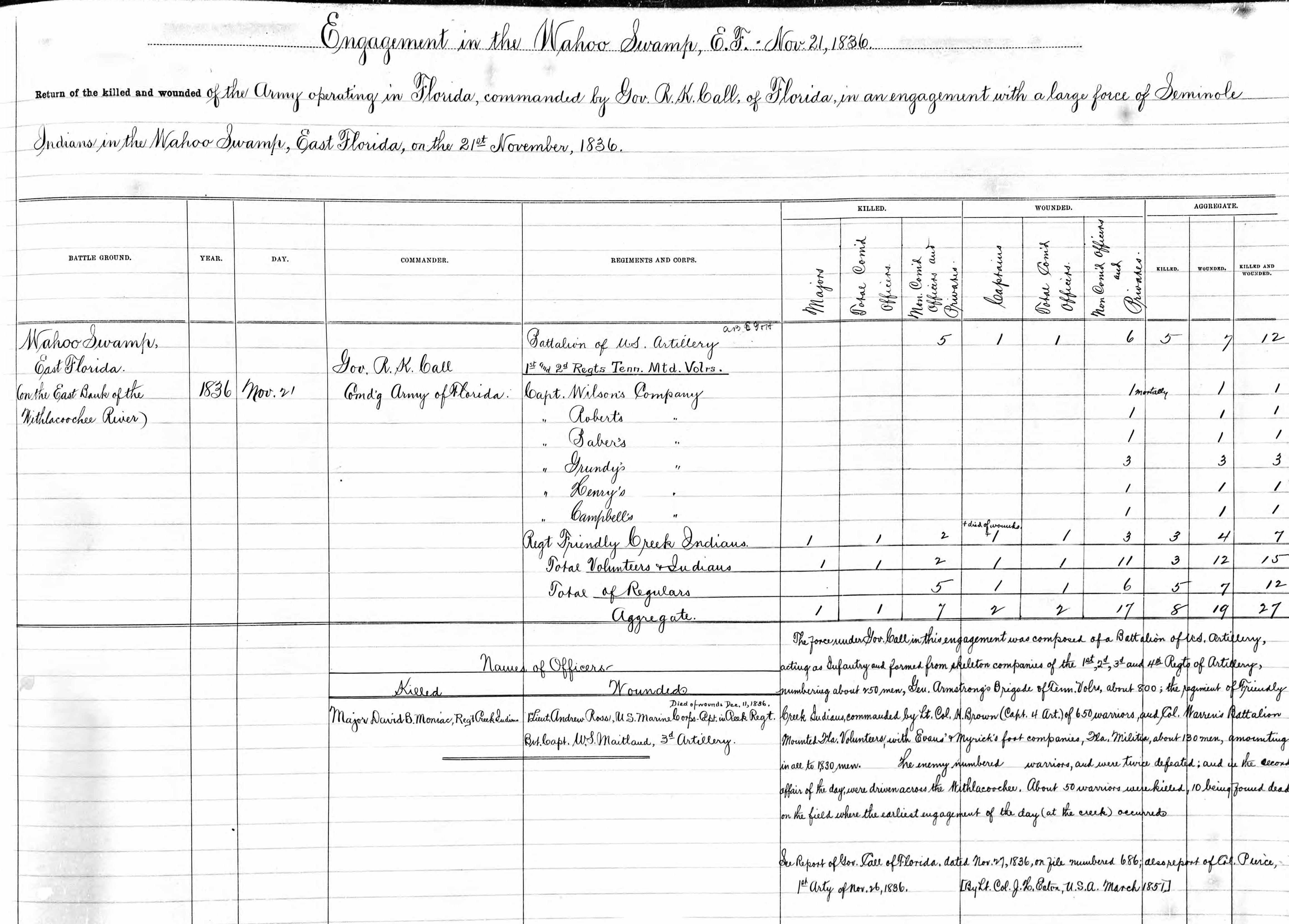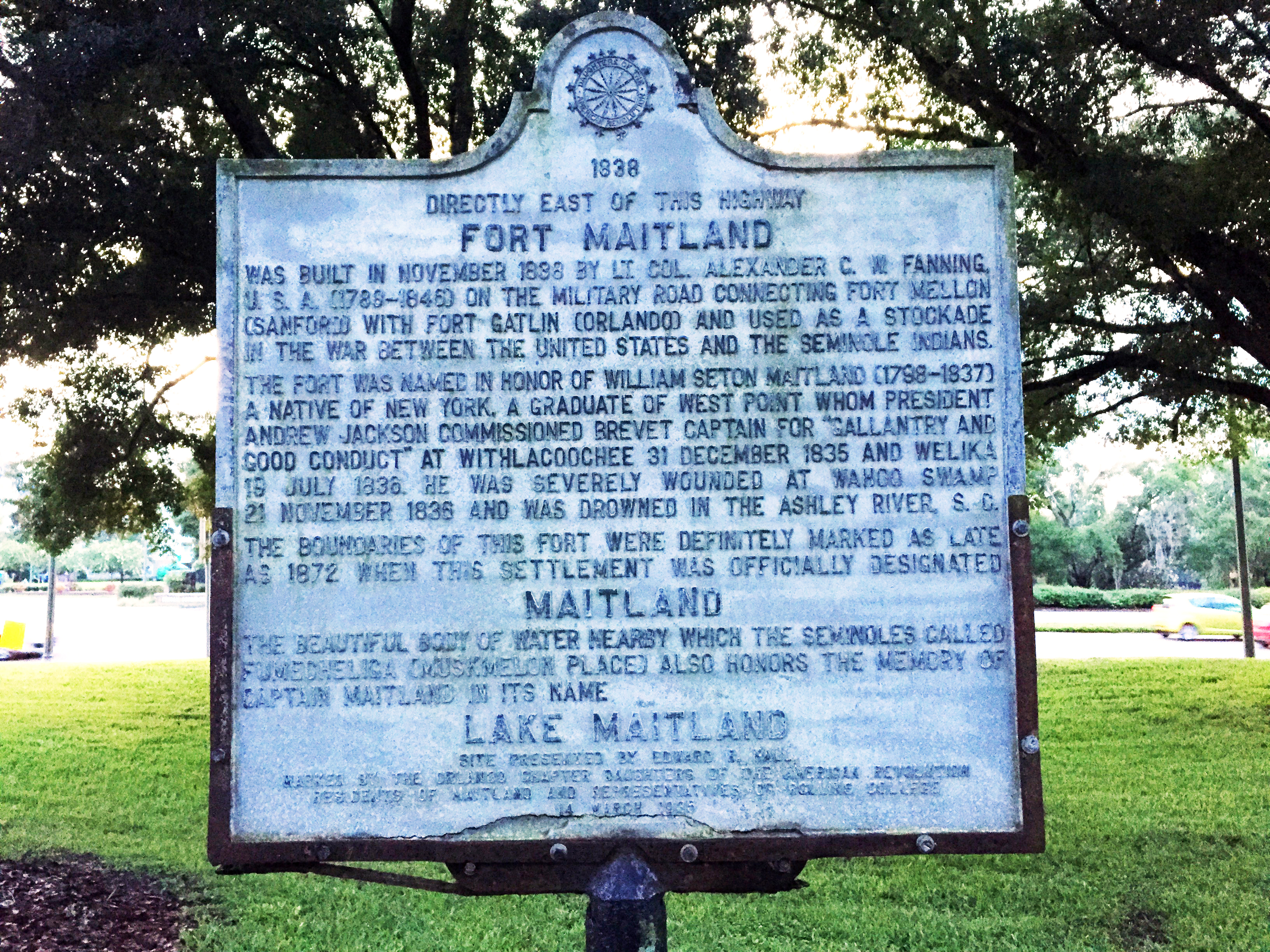William Seton Maitland (June 3, 1798–Aug. 19, 1837)
By Rhiannon O’Neil
Early Life
William Seton Maitland was born on June 3, 1798, in New York, N.Y., to James and Eliza Maitland.1 He was baptized on June 29, 1798, at Trinity Church on Wall Street.2 He spent his entire childhood in New York. On November 5, 1814, at the age of fifteen and a half, he enrolled in the U.S. Military Academy at West Point.3 He graduated twenty-eighth in a class of thirty,4 and on July 1, 1820, was commissioned as a 2nd Lieutenant in the 3rd Artillery.5
Military Service
During the fifteen years before the start of the Second Seminole War, Lt. Maitland was stationed at posts in Illinois, Wisconsin, Michigan, New York, and Connecticut.6 He spent five years, from late 1826 to early 1831, on ordnance duty at an arsenal in Pennsylvania.7 In December 1828, he was promoted to 1st Lieutenant.8
On March 14, 1835, Lt. Maitland arrived in Florida.9 He was first stationed at Fort Brooke, located on Tampa Bay. The next month, he traveled to Fort King, near present-day Ocala, to join General Duncan Clinch and his men during “their council with the leaders of the Seminoles,” including Osceola and Alligator.10 The council intended to ameliorate the misunderstandings wrought by the 1832 Treaty of Payne’s Landing.11 The treaty, negotiated by the U.S. government and Seminole leaders, stated that if land west of the Mississippi River seemed suitable to the leaders, then the tribe would relocate there. However, upon returning to Florida, it became apparent that these terms were disagreeable to the tribe at large and they refused to remove to the Indian Territory.12 General Clinch and his men were unable to reach an agreement with Osceola and the others. Lt. Maitland returned to his post at Fort King from June until December, when the Second Seminole War officially began.13
On December 25, 1835, Lt. Maitland left Fort King with Company C of the 3rd Artillery, alongside two other companies, all under Col. Alexander C.W. Fanning, who had fought in the First Seminole War (1817-1818).14 Three days later, on December 28, a contingent led by Maj. Francis L. Dade was attacked by a band of Seminoles on the road from Fort Brooke to Fort King. All but three men under Dade’s Command were killed. The event, known today a Dade’s Battle, marked the beginning of the Second Seminole War (1835-42).15
On December 31, Lt. Maitland and his men participated in the Battle of the Withlacoochee. While the troops were ferrying across the river in an old dugout canoe, a force of 250 Seminoles and escaped slaves descended upon those who had already crossed. According to the report of Gen. Duncan Clinch, who arrived from Fort Drane to help, the battle lasted approximately an hour and the Seminoles were compelled to retreat.16 Gen. Clinch wrote, “Lieutenant Maitland, who commanded a company, contributed much by his gallantry to encourage his men.”17
After six or seven months at Fort Drane, located northwest of Fort King in Marion County, 1st Lt. Maitland departed in command of Company C.18 On the march north to Fort Micanopy, on July 19, 1836, they encountered a group of about 250 Seminoles and fought near Welika Pond.19 The troops were aided by Lts. Temple and Talcott, who came from Fort Micanopy to assist in the battle.20 Once again, under Maitland’s command, the U.S. troops prevailed. For his conduct in both of these engagements, on October 15, 1836, President Andrew Jackson signed General Order No. 69 stating, “I do hereby confer on 1st Lieutenant William S. Maitland...the rank of Brevet…for gallantry and good conduct in the affair of the Wtihlacoochee and Welika…”21 This made him Brevet Captain Maitland, an honorary promotion in rank by virtue of meritorious service.
In August 1836, Capt. Maitland took a leave of absence to rest, but by October he had returned to duty at Fort Heileman (alternate spelling Heilman) near Jacksonville. In early November he reported being sick, but despite this he marched with his men to Wahoo Swamp later that month.22 On November 21, 1836, the Battle of Wahoo Swamp commenced. Both sides faced losses. The U.S. Army faced some difficulties from the terrain, including getting stuck in the mire, but after a battle of a few hours, the Seminoles began to retreat, and a company was ordered to go after them. During this prolonged engagement Capt. Maitland was severely wounded.23 He spent the next nine months resting and recuperating at Fort Heileman near Jacksonville. The fort’s monthly returns list him as “sick at Black Creek,” the body of water near which the fort was located. The wound never fully healed.24
Legacy
On August 19, 1837, on a steamboat traveling from Florida to South Carolina, Maitland suffered a “temporary fit of derangement,” according to newspapers at the time, and threw himself overboard. His drowned body was recovered the next day.25 Though it cannot be said for certain, it is likely that Maitland dealt with serious trauma from his unhealed wound from the Battle of Wahoo Swamp as well as the psychological effects of the conflict.
Maitland’s body was originally interred at Fort Johnson on James Island, S.C., but was later reinterred in the Beaufort National Cemetery at Section P61A, Site 2.26 He is memorialized, along with more than 1,400 other casualties, in the Seminole War obelisk at St. Augustine National Cemetery. His name also adorns a lake and neighboring township in central Florida. In November 1838, at the direction of Gen. Zachary Taylor, a new fort was constructed in Central Florida to strengthen U.S. defenses against the Seminoles. Colonel Fanning named it Fort Maitland to honor the brevet captain who had served with gallantry in three battles. The lake on which Fort Maitland was situated – called fumecheliga, or “muskmelon place,” by the Seminoles – became known as “Lake Maitland,” as did the town established there in 1875.”27
The Second Seminole War came to a close in 1842, five years after Maitland’s death. There was no official “winner,” only a tense peace agreement. Many Seminoles migrated to the Indian Territory west of the Mississippi, with only “less than 500” remaining. The survivors of this small group would later participate in the Third Seminole War, 1855-1858.28 Florida was granted statehood in 1845, three years after the conclusion of the Second Seminole War.29
Endnotes
1 “New York Births and Christenings, 1610-1962” database, FamilySearch.org. (https://www.familysearch.org/ : accessed June 24, 2019), entry for William Seaton Maitland.
2 “New York Births and Christenings, 1610-1962” database, FamilySearch.org. (https://www.familysearch.org/ : accessed June 24, 2019), entry for William Seaton Maitland.
3 “U.S. Military and Naval Academies Cadet Records and Applications, 1800-1908” database, Ancestry.com. (https:/www.ancestry.com/ : accessed June 24, 2019), entry for William S Maitland.
4 Alfred Jackson Hanna, Fort Maitland: Its History and Origin (Maitland, Fl.: The Fort Maitland Commitee, 1936), “William Seton Maitland,” 47.
5 “U.S. Army Register of Enlistments, 1789-1914” database, Ancestry.com. (https://www.ancestry.com/ : accessed June 24, 2019), entry for William S Maitland.
6 “U.S. Returns from Military Posts, 1806-1916” database, Ancestry.com. (https://www.ancestry.com/ : accessed June 25, 2019), entry for William S Maitland at Fort Dearborn, Illinois in January 1821.; “U.S. Returns from Military Posts, 1806-1821” database, Ancestry.com. (https://www.ancestry.com/ : accessed June 25, 2019), entry for William S Maitland at Fort Dearborn, Illinois in April 1821.; “U.S. Returns from Military Posts, 1806-1916” database, Ancestry.com. (https://www.ancestry.com/ : accessed June 25, 2019), entry for W S Maitland at Charleston Harbor, South Carolina in August 1821.; “U.S. Returns from Military Posts, 1806-1916” database, Ancestry.com. (https://www.ancestry.com/ : accessed June 25, 2019), entry for William S Maitland at Fort Shelby, Michigan in December 1822.; “U.S. Returns from Military Posts, 1806-1916” database, Ancestry.com. (https://www.ancestry.com/ : accessed June 25, 2019), entry for William S Maitland at Fort Columbus, New York in March 1825.; “U.S. Returns from Military Posts, 1806-1916” database, Ancestry.com. (https://www.ancestry.com/ : accessed June 25, 2019), entry for William S Maitland at Fort Trumbull, Connecticut in December 1832.
7 “U.S. Returns from Military Posts, 1806-1916” database, Ancestry.com. (https://www.ancestry.com/ : accessed June 25, 2019), entry for W S Maitland at Fort Washington, Maryland in November 1826. Here he is listed as “on ordnance Duty, U.S. arsenal near Frankford, Pa.”; “U.S. Returns from Military Posts, 1806-1916” database, Ancestry.com. (https://www.ancestry.com/ : accessed June 25, 2019), entry for W S Maitland at Fort Trumbull, Connecticut in February 1831.
8 Hanna, “William Seton Maitland,” 47.
9 Hanna, “William Seton Maitland,” 44.
10 Hanna, “William Seton Maitland,” 48.
11 Hanna, “William Seton Maitland,” 49.
12 “The Seminole Wars,” Seminole National Museum, last modified 2012, https://www.seminolenationmuseum.org/history/seminole-naion/the-seminole-wars/.
13 Hanna, “William Seton Maitland,” 50.
14 Hanna, “William Seton Maitland,” 50-51.
15 “Dade’s Battle (December 28, 1835),” Florida Memory Blog. (https://www.floridamemory.com/blog/2013/11/15/dades-battle-december-28-1835/ : last modified November 15, 2013).
16 Sprague, “The Florida War,” in The origin, progress, and conclusion of the Florida War; to which is appended a record of officers, non-commissioned officers, musicians, and privates of the U.S. Army, Navy, and Marine Corps, who were killed in battle, or died of disease. As also the names of officers who were distinguished by brevets, and the names of others recommended. Together with the order for collecting the remains of the dead in Florida, and the ceremony of interment at St. Augustine, East Florida, on the fourteenth day of August, 1842 (New York: D. Appleton & Co.; Philadelphia: Geo. S. Appleton, 1848, 92, https://archive.org/details/originprogressco00inspra/page/92.
17 Hanna, “William Seton Maitland,” 54.
18 Hanna, “William Seton Maitland,” 54.
19 Hanna, “William Seton Maitland,” 54.
20 “U.S. Returns of Killed and Wounded in Battles, 1790-1844” database, Ancestry.com. (https://www.ancestry.com/ : accessed June 24, 2019), entry for W S Maitland.
21 Hanna, “William Seton Maitland,” 57.; Sprague, “Appendix,” 551, https://archive.org/details/originprogressco00inspra/page/550.
22 Hanna, “William Seton Maitland,” 57-59.
23 Sprague, “The Florida War,” 163-165, https://archive.org/detail/originprogressco00inspra/page/162.
24 “U.S. Returns from Military Posts, 1806-1916” database, Ancestry.com. (https://www.ancestry.com/ : accessed June 25, 2019), entry for W S Maitland at Fort Heilman, Florida in March 1837.; “U.S. Returns from Military Posts, 1806-1916” database, Ancestry.com. (https://www.ancestry.com/ : accessed June 25, 2019), entry for W S Maitland at Fort Micanopy, Florida in June 1837.; Hanna, “William Seton Maitland,” 60.
25 “From the Charleston Patriot of August 19,” in The Army and Navy Chronicle, Vols. IV-V, ed. Benjamin Homans (B. Homans, 1837), 122.
26 “U.S. National Cemetery Interment Control Forms, 1928-1962” database, Ancestry.com. (https://www.ancestry.com/ : accessed June 24, 2019), entry for William S Maitland.; “Maitland, William S,” National Cemetery Administration, accessed June 25, 2019, https://gravelocatory.cem.va.gov/NGLMap?ID=3399327.
27 Hanna, “The Building of Fort Maitland,” 63, 70, 84.
28 “The Seminole Wars,” Seminole National Museum, last modified 2012, https://www.seminolenationmuseum.org/history/seminole-naion/the-seminole-wars/.
29 “Act Establishing Florida Statehood, 1845,” Florida Memory. (https://www.floridamemory.com/exhibits/floridahighlights/admitunion/ : accessed June 4, 2019).
© 2019, University of Central Florida




